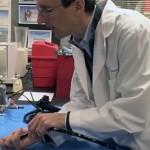Yesterday the FDA released a safety communication advising that healthcare providers begin the shift to using duodenoscopes that do not need to be reprocessed. “These devices have complex designs that include reusable hard-to-clean components. Failure to correctly reprocess a duodenoscope could result in tissue or fluid from one patient remaining in a duodenoscope when it is used on a subsequent patient. In rare cases, this can lead to patient-to-patient disease transmission,” FDA stated in the safety communication.
“We recognize that a full transition away from conventional duodenoscopes to innovative models will take time and immediate transition is not possible for all health care facilities due to cost and market availability,” said CDRH Director Jeff Shuren, M.D. in an agency news release. “This is why we’re communicating with health care facilities now—so they can begin developing a transition plan to replace conventional duodenoscopes—and those facilities that are purchasing duodenoscopes with fixed endcaps can invest in the newer, innovative models. We are also encouraging the manufacturers of these duodenoscope models to assist health care facilities with their transition plans.”
The FDA also provided an update on the mandated postmarket surveillance study results for duodenoscopes used in endoscope retrograde cholangiopancreatography, a procedure that assesses problems in the bile and pancreatic ducts. The study required Fujifilm, Olympus and Pentax, U.S. manufacturers of duodenoscopes, to assess whether healthcare staff understood and followed the instructions for reprocessing the devices in real-world settings. Results implied that device users did not fully understand nor did they follow the reprocessing instructions, and as a result, the reprocessing procedure was not adequately carried out.
As part of a postmarket surveillance study, new mandates from FDA require duodenoscope manufacturers that use disposable endcaps on their devices to collect more information and confirm that these new designs lower the contamination rate. Once the study is completed, the duodenoscopes with these endcaps must have updated labeling that includes data on the contamination rate.
FDA has also warned healthcare facilities against the use of adenosine triphosphate (ATP) test strips to evaluate duodenoscope cleaning, as the agency has not determined their effectiveness. ATP test strip manufacturers that claim their products can be used to assess duodenoscope cleaning should submit data to support legally marketing their strips for this use, advises FDA.
Later this year the agency will convene its General Hospital and Personal Use Device Panel of the Medical Device Advisory Committee to review duodenoscope reprocessing.
The agency’s safety communication, “The FDA is Recommending Transition to Duodenoscopes with Innovative Designs to Enhance Safety”, is available online.






